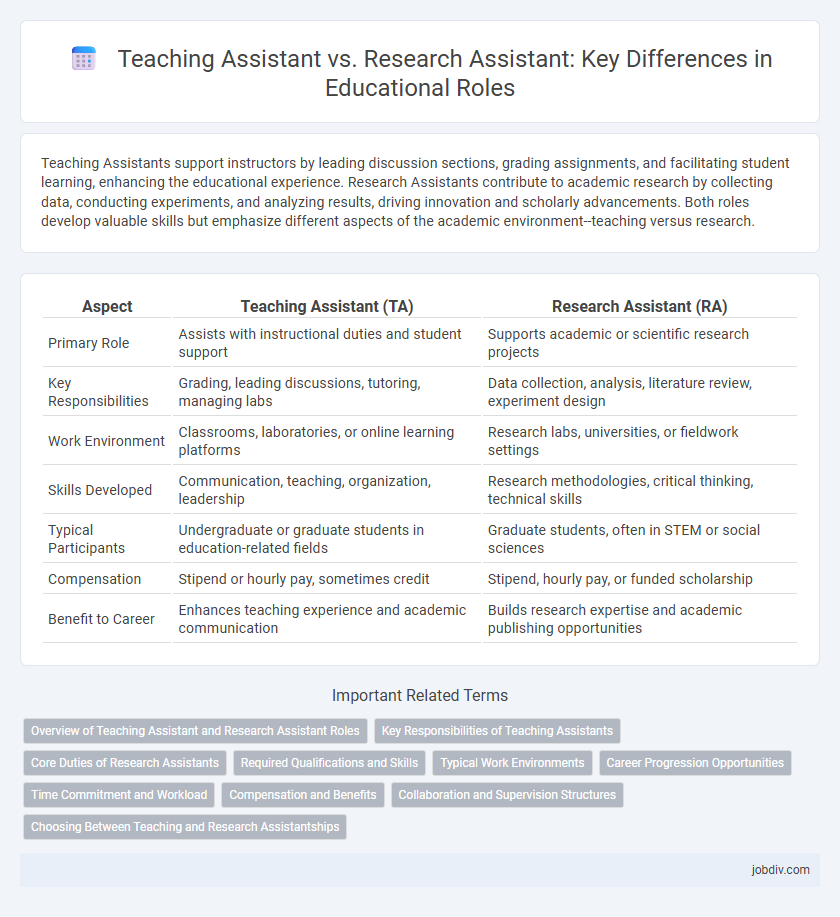Teaching Assistants support instructors by leading discussion sections, grading assignments, and facilitating student learning, enhancing the educational experience. Research Assistants contribute to academic research by collecting data, conducting experiments, and analyzing results, driving innovation and scholarly advancements. Both roles develop valuable skills but emphasize different aspects of the academic environment--teaching versus research.
Table of Comparison
| Aspect | Teaching Assistant (TA) | Research Assistant (RA) |
|---|---|---|
| Primary Role | Assists with instructional duties and student support | Supports academic or scientific research projects |
| Key Responsibilities | Grading, leading discussions, tutoring, managing labs | Data collection, analysis, literature review, experiment design |
| Work Environment | Classrooms, laboratories, or online learning platforms | Research labs, universities, or fieldwork settings |
| Skills Developed | Communication, teaching, organization, leadership | Research methodologies, critical thinking, technical skills |
| Typical Participants | Undergraduate or graduate students in education-related fields | Graduate students, often in STEM or social sciences |
| Compensation | Stipend or hourly pay, sometimes credit | Stipend, hourly pay, or funded scholarship |
| Benefit to Career | Enhances teaching experience and academic communication | Builds research expertise and academic publishing opportunities |
Overview of Teaching Assistant and Research Assistant Roles
Teaching Assistants support instructors by leading discussion sections, grading assignments, and providing student office hours, enhancing the classroom learning experience. Research Assistants contribute to academic investigations by collecting data, conducting experiments, and assisting in the preparation of scholarly publications. Both roles are integral to higher education, fostering academic growth and advancing knowledge within university departments.
Key Responsibilities of Teaching Assistants
Teaching Assistants primarily support professors by conducting discussion sections, grading assignments, and providing student feedback to enhance learning outcomes. They facilitate classroom activities, hold office hours for student inquiries, and may assist in developing instructional materials to improve course delivery. Their role is essential in managing student engagement and ensuring comprehensive understanding of the curriculum.
Core Duties of Research Assistants
Research Assistants primarily focus on supporting academic studies by collecting data, conducting experiments, and analyzing results under faculty supervision. They are responsible for literature reviews, maintaining research documentation, and contributing to scholarly publications. Their core duties emphasize assisting in the development and execution of research projects to advance knowledge within a specific academic discipline.
Required Qualifications and Skills
Teaching Assistants typically require strong communication skills, subject matter expertise, and the ability to lead discussions or grade assignments, often necessitating at least an undergraduate degree in the relevant field. Research Assistants need proficiency in research methodologies, data analysis software, and critical thinking, with qualifications usually including experience in laboratory or fieldwork and sometimes prior publication records. Both roles demand organizational skills and teamwork, but Research Assistants emphasize technical research capabilities, whereas Teaching Assistants focus on instructional support.
Typical Work Environments
Teaching Assistants typically work in academic settings such as classrooms, lecture halls, and laboratories, supporting instructors with grading, student interaction, and course material preparation. Research Assistants are often based in research labs, universities, or field sites, conducting experiments, collecting data, and assisting with publications. Both roles require collaboration with faculty but differ significantly in their work environments and daily responsibilities.
Career Progression Opportunities
Teaching Assistants gain valuable experience in instructional methods and student engagement, which can lead to careers in education, academic administration, or curriculum development. Research Assistants develop skills in data analysis, experimental design, and scholarly writing, often paving the way for advanced study or careers in research, academia, or industry-specific roles. Career progression for Teaching Assistants often involves roles like lecturer or educational coordinator, while Research Assistants may advance to positions such as principal investigator or research scientist.
Time Commitment and Workload
Teaching Assistants typically commit 10-20 hours per week managing classroom activities, grading assignments, and leading discussion sections, resulting in a structured but consistent workload. Research Assistants often face variable hours, ranging from 15-25 per week, focused on experimental design, data collection, and analysis, which can intensify during project deadlines. Time commitment for Research Assistants is generally less predictable, with workloads fluctuating based on the demands of specific research projects.
Compensation and Benefits
Teaching Assistants (TAs) typically receive compensation in the form of stipends, tuition waivers, or hourly wages, with benefits often including health insurance and access to university resources. Research Assistants (RAs) usually earn higher stipends or salaries funded by research grants, with benefits that may extend to professional development opportunities and conference funding. Compensation packages vary significantly by institution, funding source, and the specific responsibilities associated with either role.
Collaboration and Supervision Structures
Teaching Assistants often collaborate closely with professors and students, providing academic support and facilitating classroom activities under direct supervision to enhance learning experiences. Research Assistants typically work within research teams, collaborating on specific projects and contributing to data collection, analysis, and publication efforts while being supervised by principal investigators. Both roles require effective communication and coordination, but Teaching Assistants focus more on educational support, whereas Research Assistants emphasize research development and scholarly output.
Choosing Between Teaching and Research Assistantships
Choosing between teaching and research assistantships depends on career goals and skill development priorities. Teaching assistantships enhance communication, leadership, and instructional skills through direct classroom involvement. Research assistantships offer hands-on experience in data analysis, experimental design, and academic publishing, vital for pursuing advanced research or doctoral studies.
Teaching Assistant vs Research Assistant Infographic

 jobdiv.com
jobdiv.com